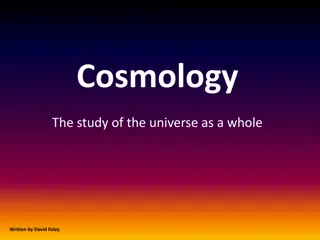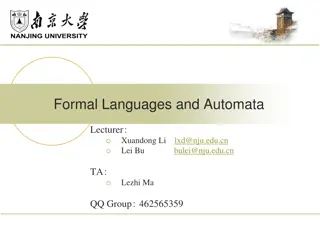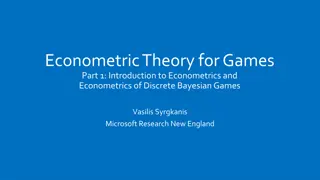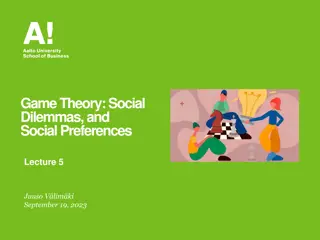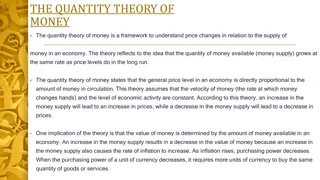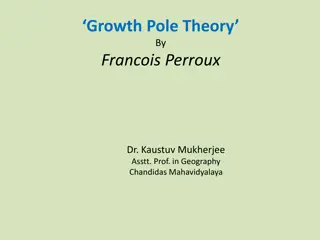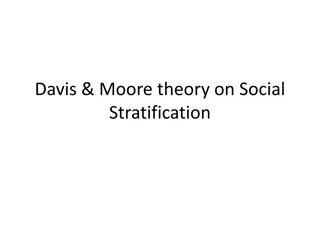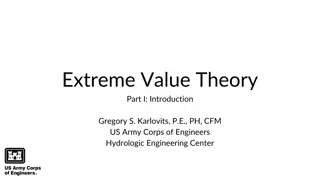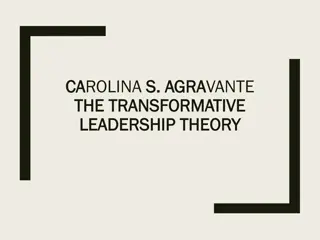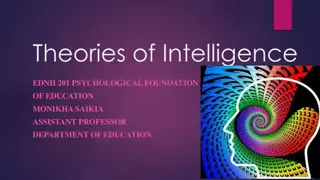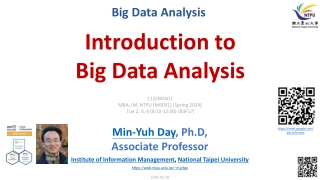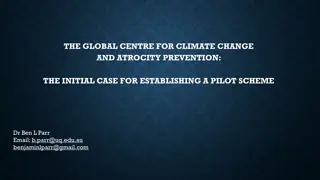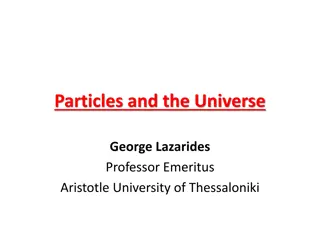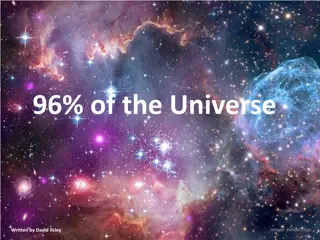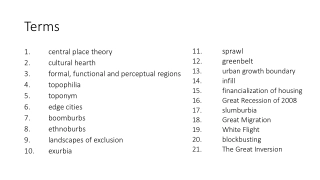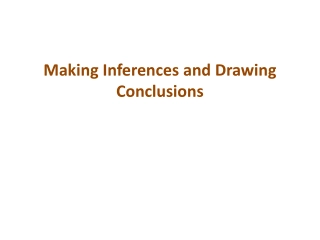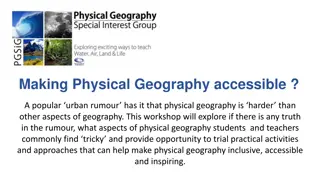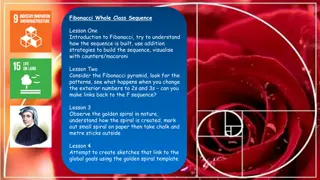Unraveling the Big Bang Theory and the Origins of the Universe
Explanation of the Big Bang Theory by Matthew Kogan, detailing the formation of the universe from a hot, dense mass expanding outward. As the universe cooled, particles formed, leading to the creation of stars and galaxies. The theory explores the imbalance between matter and antimatter, the intense radiation in the early universe, and the formation of atoms. Scientists continue to study the origins and evolution of our universe based on new evidence and understanding.
Unraveling the Big Bang Theory and the Origins of the Universe
PowerPoint presentation about 'Unraveling the Big Bang Theory and the Origins of the Universe'. This presentation describes the topic on Explanation of the Big Bang Theory by Matthew Kogan, detailing the formation of the universe from a hot, dense mass expanding outward. As the universe cooled, particles formed, leading to the creation of stars and galaxies. The theory explores the imbalance between matter and antimatter, the intense radiation in the early universe, and the formation of atoms. Scientists continue to study the origins and evolution of our universe based on new evidence and understanding.. Download this presentation absolutely free.
Presentation Transcript
The Big Bang Thoery By Matthew Kogan
In science, a theory is an explanation of a big idea for which there is a lot of scientific evidence. A scientific theory can be supported by new evidence. New evidence might modify or disprove a scientific theory. A scientific theory can never be proven like a scientific law (we can never be 100% certain). The Big Bang Theory explains how our universe was formed based on all the scientific evidence available. The theory seems to be the most sensible with the information we currentlyhave. Georges lemaitre came up with the big bang theory in 1921 All the matter of the entire universe was in a small, extremely hot mass that expanded quickly outwards under tremendous pressure. This beginning is called time zero.What happened before this is not known.
As time passed and matter cooled, more diverse kinds of particles began to form, and they eventually condensed into the stars and galaxies of our present universe. By the time the universe was a billionth of a second old, the universe had cooled down enough for the four fundamental forces to separate from one another. The universe's fundamental particles also formed. It was still so hot, though, that these particles hadn't yet assembled into many of the subatomic particles we have today, such as the proton. As the universe kept expanding, this piping-hot primordial soup called the quark-gluon plasma continued to cool. Some particle colliders, such as CERN's Large Hadron Collider, are powerful enough to re-create the quark-gluon plasma.
Somehow, some excess matter survivedand it's now the stuff that people, planets, and galaxies are made of. Our existence is a clear sign that the laws of nature treat matter and antimatter slightly differently. Researchers have experimentally observed this rule imbalance, called CP violation, in action. Physicists are still trying to figure out exactly how matter won out in the early universe. The Big Bang was like no explosion you might witness on earth today. For instance, a hydrogen bomb explosion, whose center registers approximately 100 million degrees Celsius, moves through the air at about 300 meters per second. In contrast, cosmologists believe the Big Bang flung energy in all directions at the speed of light (300,000,000 meters per second, a million times faster than the H-bomb) and estimate that the temperature of the entire universe was 1000 trillion degrees
Radiation in the early universe was so intense that colliding photons could form pairs of particles made of matter and antimatter, which is like regular matter in every way except with the opposite electrical charge. It's thought that the early universe contained equal amounts of matter and antimatter. But as the universe cooled, photons no longer packed enough punch to make matter-antimatter pairs.
Building atoms Within the universe's first second, it was cool enough for the remaining matter to coalesce into protons and neutrons, the familiar particles that make up atoms' nuclei. And after the first three minutes, the protons and neutrons had assembled into hydrogen and helium nuclei. By mass, hydrogen was 75 percent of the early universe's matter, and helium was 25 percent. The abundance of helium is a key prediction of big bang theory, and it's been confirmed by scientific observations.
Despite having atomic nuclei, the young universe was still too hot for electrons to settle in around them to form stable atoms. The universe's matter remained an electrically charged fog that was so dense, light had a hard time bouncing its way through. It would take another 380,000 years or so for the universe to cool down enough for neutral atoms to form a pivotal moment called recombination. The cooler universe made it transparent for the first time, which let the photons rattling around within it finally zip through unimpeded.
We still see this primordial afterglow today as cosmic microwave background radiation, which is found throughout the universe. The radiation is similar to that used to transmit TV signals via antennae. But it is the oldest radiation known and may hold many secrets about the universe's earliest moments.
There wasn't a single star in the universe until about 180 million years after the big bang. It took that long for gravity to gather clouds of hydrogen and forge them into stars. Many physicists think that vast clouds of dark matter, a still-unknown material that outweighs visible matter by more than five to one, provided a gravitational scaffold for the first galaxies and stars. Once the universe's first stars ignited, the light they unleashed packed enough punch to once again strip electrons from neutral atoms, a key chapter of the universe called reionization. In February 2018, an Australian team announced that they may have detected signs of this cosmic dawn. By 400 million years after the big bang, the first galaxies were born. In the billions of years since, stars, galaxies, and clusters of galaxies have formed and reformed eventually yielding our home galaxy, the Milky Way, and our cosmic home, the solar system.
Even now the universe is expanding, and to astronomers' surprise, the pace of expansion is accelerating. It's thought that this acceleration is driven by a force that repels gravity called dark energy. We still don't know what dark energy is, but it s thought that it makes up 68 percent of the universe's total matter and energy. Dark matter makes up another 27 percent. In essence, all the matter you've ever seen from your first love to the stars overhead makes up less than five percent of the universe
Alternative theories Steady State Theory- Development of the universe is the Steady State model. Emerging as one of the first opponents to the Big Bang theory, Steady State postulates continuous creation of matter all over the universe to explain its discernible expansion. This sort of universe would be infinite, without a beginning or an end. Be that as it may, the abundance of evidence and data collected since the mid-1960s successfully disproves this theory to this day. The Black Hole Theory- Universe came from a black hole of another universe. Therefore, we are living outside its event horizon. In an alternate version of the theory, the observable universe is the inside of a black hole subsiding as one of potentially many within a larger parent universe, or multiverse. In this respect, we can claim that a new universe lies behind every black hole. Given that we cannot pass the event horizon of a black hole, there is no way to clearly prove or disprove this theory.
Citations Evidence for the big bang - university of western australia. (n.d.). Retrieved November 29, 2021, from https://www.uwa.edu.au/study/- /media/Faculties/Science/Docs/Evidence-for-the-Big- Bang.pdf. NASA. (n.d.). The big bang. NASA. Retrieved November 29, 2021, from https://science.nasa.gov/astrophysics/focus-areas/what- powered-the-big-bang. Howell, E. (2021, November 5). What is the Big Bang Theory? Space.com. Retrieved November 29, 2021, from https://www.space.com/25126-big-bang-theory.html. Siegel, E. (2020, February 21). These 4 pieces of evidence have already taken us beyond the big bang. Forbes. Retrieved November 29, 2021, from https://www.forbes.com/sites/startswithabang/2020/02/21/t hese-4-pieces-of-evidence-have-already-taken-us-beyond- the-big-bang/?sh=77141f7e7a0b.
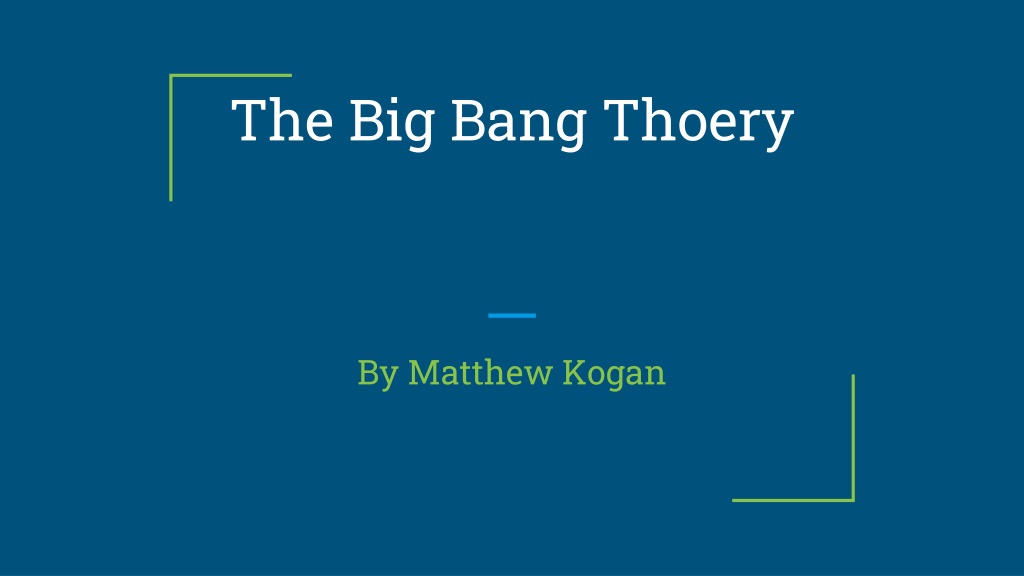

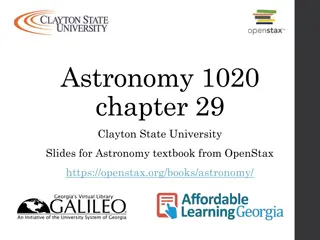


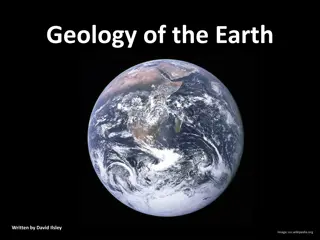
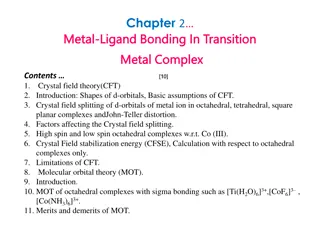
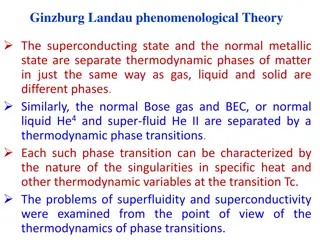
![Read⚡ebook✔[PDF] Life in the Universe: Expectations and Constraints (Springer P](/thumb/21626/read-ebook-pdf-life-in-the-universe-expectations-and-constraints-springer-p.jpg)
![textbook$ What Your Heart Needs for the Hard Days 52 Encouraging Truths to Hold On To [R.A.R]](/thumb/9838/textbook-what-your-heart-needs-for-the-hard-days-52-encouraging-truths-to-hold-on-to-r-a-r.jpg)
